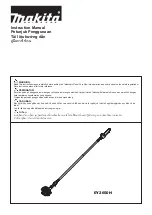
9
English
k. Do not use any chain saw blade or
toothed saw blade or a segmented
diamond cutting disc with slot widths
of more than 10 mm.
Such fitted tools
often cause kickback or a loss of con-
trol over the power tool.
l. Avoid jamming the cutting disc or
applying to much pressure to it. Do
not perform any excessively deep
cuts.
Overloading the cutting disc will
increase the stress on it and make it
susceptible to canting or jamming,
which could cause it to kick back or the
grinding tool to break.
m. Do not switch the power tool back on
while it is still in the work piece. First
allow the cutting disc to reach its full
speed before you carefully continue
cutting with it.
Otherwise the disc
could catch, jerk out of the work piece
or cause kickback.
n. Warning! Inhaling or contact with
resulting dust is hazardous for the
operator as well as nearby persons.
Therefore avoid cutting through harm-
ful/toxic materials such as paint coats
containing lead, some types of wood
and metal and use a dust extractor as
well as personal protective equipment
such as a dust mask.
o. Always wear ear protection.
p. Hold the device by the insulated grip-
ping surfaces as the cutting disc
could come into contact with its own
mains cable.
Damaging a live line could
also energise metallic parts of the
device and inflict an electric shock.
5.2.
Safety instructions for this pre-
cision plunge saw
Safety instructions for saws with a pro-
tective hood
a. Check whether the protective hood
can be properly closed before each
use. Do not use the saw if the protec-
tive hood cannot be moved freely and
does not close immediately. Never
clamp or tie the protective hood in
place as the saw blade would not be
protected as a result.
If the saw acci-
dentally falls on the ground, the protec-
tive hood could be bent. Make sure that
the protective hood moves freely and
does not touch either the saw blade or
other parts at all cutting angles and
depths.
b. Check the condition and function of
the spring for the protective hood.
Before use, have maintenance per-
formed on the saw if the protective
hood and spring are not working prop-
erly.
Damaged parts, sticky deposits or
any buildup of chips will delay the effec-
tiveness of the bottom protective hood.
c. When “plunge cutting” at angles other
than a right angle, secure the base
plate of the saw to prevent it from
sliding to the side.
If it slides to the
side, the saw blade can catch resulting
in kickback.
d. Do not set the saw down on the work
bench or the ground without the pro-
tective hood covering the saw blade.
A
saw blade that is not protected and still
rotating will move the saw against the
direction of cutting and will cut through
whatever is in its way. Note the time the
saw needs to come to a stop in the
process.
e.
Do not use grinding wheels for cutting.
f.
Only use saw blades with diameters
corresponding to the labels on the saw.
g.
Always use a suitable dust extractor
when cutting wood.
h.
Always wear a dust mask when cutting
wood.
i.
Only use the saw blades recommended
by the manufacturer.
j.
Always wear ear protection.
k.
When cutting through plastic, avoid
overheating the tips of the saw teeth
and melting the plastic.
5.3.
Safety instructions for cut-off
grinding applications
Safety instructions for cutting-off
machines
a. The protective hood belonging to the
power tool must be securely mounted
and set so that it provides maximum
7063051-Thor-Compact-Ma-1804-30.indb 9
04-06-18 11:55












































